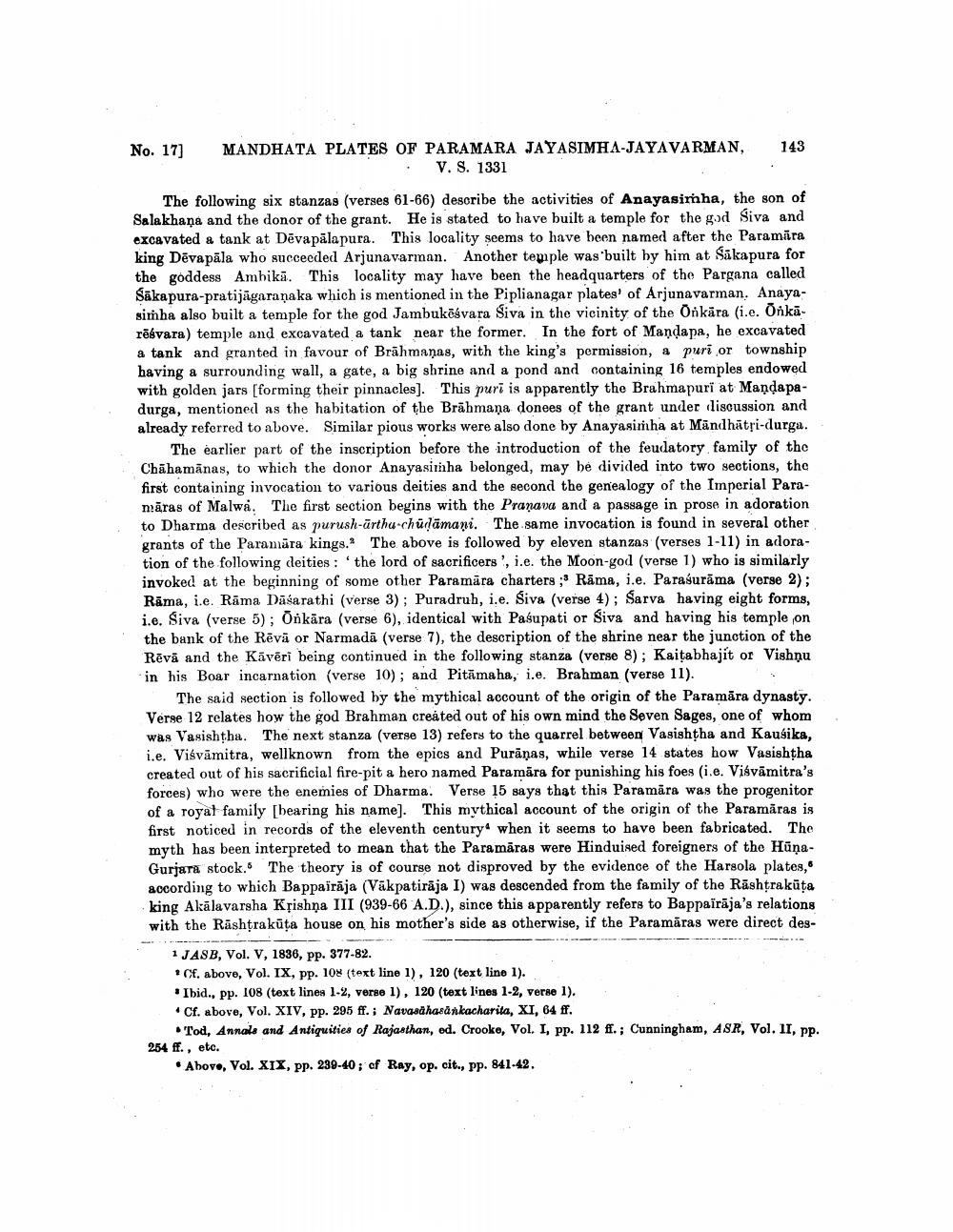________________
No. 17]
143
MANDHATA PLATES OF PARAMARA JAYASIMHA-JAYAVARMAN,
• V. S. 1331
The following six stanzas (verses 61-66) describe the activities of Anayasimha, the son of Salakhana and the donor of the grant. He is stated to have built a temple for the god Siva and excavated a tank at Dévapälapura. This locality seems to have been named after the Paramāra king Dēvapāla who succeeded Arjunavarman. Another temple was built by him at Sākapura for the goddess Ambika. This locality may have been the headquarters of the Pargana called Sākapura-pratijagaranaka which is mentioned in the Piplianagar plates of Arjunavarman. Anayasimha also built a temple for the god Jambukēsvara Siva in the vicinity of the Onkära (ie. Onkārēsvara) temple and excavated a tank near the former. In the fort of Mandapa, he excavated a tank and granted in favour of Brāhmaṇas, with the king's permission, a purior township having a surrounding wall, a gate, a big shrine and a pond and containing 16 temples endowed with golden jars [forming their pinnacles). This puri is apparently the Brahmapuri at Mandapadurga, mentioned as the habitation of the Brāhmaṇa donees of the grant under discussion and already referred to above. Similar pious works were also done by Anayasimha at Māndhātri-durga.
The earlier part of the inscription before the introduction of the feudatory family of the Chāhamānas, to which the donor Anayasimha belonged, may be divided into two sections, the first containing invocation to various deities and the second the genealogy of the Imperial Paramāras of Malwa. The first section begins with the Pranava and a passage in prose in adoration to Dharma described as purush-ürthu-chudamani. The same invocation is found in several other grants of the Paramāra kings. The above is followed by eleven stanzas (verses 1-11) in adoration of the following deities : 'the lord of sacrificers', i.e. the Moon-god (verse 1) who is similarly invoked at the beginning of some other Paramāra charters ;' Rāma, i.e. Parasurama (verse 2); Rāma, i.e. Rāma Dasarathi (verse 3); Puradruh, i.e. Siva (verge 4); Sarva having eight forms, i.e. Siva (verse 5); Onkära (verse 6), identical with Pasupati or Siva and having his temple on the bank of the Rēva or Narmadā (verse 7), the description of the shrine near the junction of the Rēvā and the Kāvēri being continued in the following stanza (verse 8); Kaitabhajít or Vishnu in his Boar incarnation (verse 10); and Pitāmaha, i.e. Brahman (verse 11).
The said section is followed by the mythical account of the origin of the Paramāra dynasty. Verse 12 relates how the god Brahman created out of his own mind the Seven Sages, one of whom was Vasishtha. The next stanza (verse 13) refers to the quarrel between Vasishtha and Kausika, i.e. Visvāmitra, wellknown from the epics and Purānas, while verse 14 states how Vasishtha created out of his sacrificial fire-pit a hero named Paramāra for punishing his foes (i.e. Visvāmitra's forces) who were the enemies of Dharma. Verse 15 says that this Paramāra was the progenitor of a royal family [hearing his name). This mythical account of the origin of the Paramaras is first noticed in records of the eleventh century when it seems to have been fabricated. The myth has been interpreted to mean that the Paramāras were Hinduised foreigners of the HūņaGurjara stock. The theory is of course not disproved by the evidence of the Harsola plates, according to which Bappairāja (Vākpatirāja I) was descended from the family of the Rāshtrakūta king Akālavarsha Kșishna III (939-66 A.D.), since this apparently refers to Bappaïräja's relations with the Rashtrakūta house on his mother's side as otherwise, if the Paramāras were direct des
1 JASB, Vol. V, 1836, pp. 377-82. . cf. above, Vol. IX, pp. 108 (text line 1), 120 (text line 1).
Ibid., pp. 108 (text lines 1-2, verse 1), 120 (text lines 1-2, verse 1). . Cf. above, Vol. XIV, pp. 295 ff.; Navasähasankacharita, XI, 64 ff.
Tod, Annals and Antiquities of Rajasthan, ed. Crooke, Vol. I, pp. 112 ff.; Cunningham, ASR, Vol. II, pp. 254 ff., etc.
• Above, Vol. XIX, pp. 289-40; cf Ray, op. cit., pp. 841-42.




